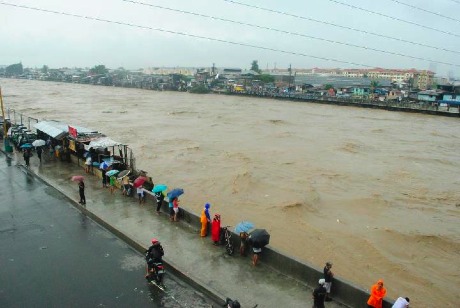With word out that “unprecedented” heavy rains may continue well into Thursday the 9th of August, persistent floods are expected to spawn a new risk to health. Diarrhea outbreaks now pose a threat to thousands of Filipinos impacted by flood waters. Health Secretary Enrique Ona has issued warnings about the dangers of contaminated drinking water and urged people to take precautions…
“Water must be purified to ensure that it is clean and fit for human consumption. Water that is not safe to drink can make you sick from a few hours or up to several weeks after taking it,†Ona said.
Pure clean water must be used for drinking, cooking, brushing teeth, and other activities avoid outbreaks of diarrhea.

Manggahan Floodway at Ortigas Extension brimming with flood waters
[Photo courtesy Twinsy Adajar.]
| SUPPORT INDEPENDENT SOCIAL COMMENTARY! Subscribe to our Substack community GRP Insider to receive by email our in-depth free weekly newsletter. Opt into a paid subscription and you'll get premium insider briefs and insights from us. Subscribe to our Substack newsletter, GRP Insider! Learn more |
The following are measures to help ensure the safety of drinking water during handling, transport, and storage issued by the Department of Health:
Ways of protecting water from contamination during handling, transport and storage
• always use clean water containers provided with cover
• wash containers after every use
• clean and disinfect storage tanks at least every quarter
• avoid hand contact with water during transportMethods of water treatment
• Boiling – water should be brought to a rolling boil for at least two (2) minutes
• Disinfection – by using chlorine1. Prepare a stock solution by dissolving 1 level of powder. Chlorine compounds (65% to 75% available chlorine) to 1 liter of water.
2. Add 2 teaspoons of stock solution to 5 gallons (20 liters) of water. Mix thoroughly and let it stand for atleast 30 minutes before using.
According to the World Health Organisation fact sheet on flooding, the only epidemic-prone disease related to flooding is leptospirosis…
Transmission [of leptospirosis] occurs through contact of the skin and mucous membranes with water, damp soil or vegetation (such as sugarcane) or mud contaminated with rodent urine. The occurrence of flooding after heavy rainfall facilitates the spread of the organism due to the proliferation of rodents which shed large amounts of leptospires in their urine.
The report also debunked a common misconception…
Contrary to common belief, there is no evidence that corpses pose a risk of disease “epidemics” after natural disasters. Most agents do not survive long in the human body after death (with the exception of HIV -which can be up to 6 days) and the source of acute infections is more likely to be the survivors. Human remains only pose health risks in a few special cases requiring specific precautions, such as deaths from cholera or haemorrhagic fevers.
benign0 is the Webmaster of GetRealPhilippines.com.
We sincerely sympathize with our suffering countrymen. May you all find solace and consolations in your prayers, being answered…